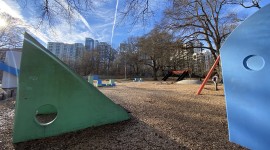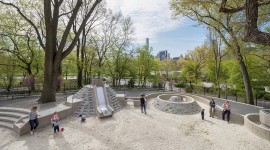Playground
A space designed primarily to accommodate spontaneous and organized play for children in order to foster their creative, cognitive, social and physical development, evolving from the nineteenth century to the present according to prevailing theories of education, developmental psychology, and aesthetics. In the U.S., playgrounds based in part on European precedents originated in urban environments, with supervised playgrounds intended to act as agents of social reform, promoting good behavior, developing citizenship, preventing crime, and providing safe play environments. Beginning in the early twentieth century, playgrounds were frequently located on school grounds and served a dual function as recreation for school children and small neighborhood parks fostering community identity. Also during the same period playgrounds began to be included as essential elements in the design of larger parks. These practices are still in effect today in many urban and suburban areas.














